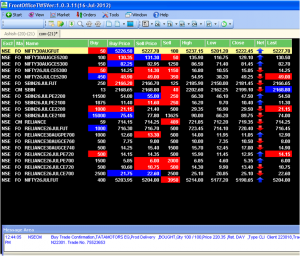
Co Owner at findtutoronline.net
The Brand and its creation
“A brand can be defined as a specific name, symbol or design – or, more usually, some combination of these – that is used to distinguish a particular seller’s product”. Doyle et al. (2006, p.164)
Brands transform experiences and provide a difference. It carries a badge of recognition, trust and a promise of performance. Paul Feldwick as cited in (Ind, 2004).
Companies have different brand messages and the process is multi faceted as it is about different perceptions about the company which is created through press, interactions with people, the advertising, the layout of the website, the quality of the product and after sales services. (Ind, 2004). A company can have many branded products and still be relatively unknown to general consumer (like P&G). For e.g., Porsche was originally a group of five companies, but had only two major brands. This indicates that a company may have numerous product lines but its consumers and their perception towards it define a brand.
Definition of branding
“The brand is the property of the corporation (as trade marks, brands are intangible assets that are legally owned by companies to be bought, sold, invested in or milked to death as the formal owner sees fit). And itspurpose is to help the corporation achieve its goals, eg to maximize profits or shareholder value.” (Ind, 2003).Thus a brand has to evolve along with the company and grow with the aided and unaided consumer preferences (Kapferer, 2004).
Branding
Strong Brand recognition is not just created by advertising but it has to deliver the value simultaneously. Advertising would only shape up the perceptions about a particular product or service but the actual challenge is to deliver consistent value to the customers.
Brand is the “personality” of the company perceived in the consumer’s mind. To create a successful brand, a company needs to create awareness and the products needs to meet the functional needs of the customers. Advertisements and promotions will help to accomplish this to some extent, but creating a preference among the consumers is a difficult task. Many suppliers create awareness but may not be liked by large groups in the market. Therefore to be a successful brand it is important to also meet the psychological needs of the consumers. This adds value and builds confidence among people to desire a particular brand of product than the competitors. (Doyle, 2006)
Brand architecture strategy
Figure 2 The Brand Architecture (source: Kapferer ,2004)
Kapferer (2004) has defined six types of brand architecture strategies on the basis of the level brands and amount of freedom to define products and services. Product brand architecture is defined as the strategy to focus on a single product. Thus, it will have a distinct advantage of whole brand name for itself. For e.g. P&G have several products that are branded individually. On the other hand, Umbrella Brand architecture encompasses entire set of products under one brand name. Also, Source brand is similar to umbrella brand with one major distinction that in a source branding strategy, every product is a brand in itself. Although a Maker’s Mark architecture is very different in its approach as it focuses on branding products by its source manufacturer. But Endorsing brand use the benefit of endorsement as the emblem to promote the brand. (Kapferer ,2004)
Section 2: Brand positioning
“Positioning a brand means emphasizing the distinctive characteristics that make it different from its competitors and appealing to the public.” (Kapferer, 2004) It will help in streamlining all the marketing activities to focus on establishing its superiority in consumers mind. It will help to superimpose its association with consumer’s preference and in turn differentiate itself from the competitive products (Keller et al. 2002).
According to Kapferer (1997), positioning doesn’t confine a brand meaning and its actual potential. It merely answers to the consumer’s comparative analysis of similar products. It may boil down to following four questions:
- Why: It talks about the promises and benefits that a brand offers to its consumer.
- For whom: It describes the target segment of the brand.
- When: It refers to the occasions that would initiate the usage of brand.
- Against whom: It defines the main competitors of the brand that it may compete to acquire market share.
The following diagram would summaries these crucial questions regarding brad positioning:
Another very important tool for brand positioning is perceptual mapping in the market place (Jobber, 2001, Fill, 2002). Perceptual mapping is defined as the diagrammatic representation of consumer perceptions of the brand and its competitors in terms of pre-specified dimensions. These dimensions are shaped by the user preferences (Jobber, 2001). The four major steps for brand positioning, according to Aaker (1996), are determining the set of value prepositions, define target audience and then actively communicate their point of superiority. The pictorial representation of identification of a brand position and its future positioning opportunities is as follows:
Thus, Positioning is a two-step process. The first step is identification of target audience and major competitors in its target category. The second step involves communicating its point of competitive advantage in comparison to other brands in the same category (Kapferer, 1997).
Design and positioning statement
When a company decides to design its positioning strategies to streamline its marketing communications and brand attributes, it first needs to identify its brand meaning in its prospective consumer’s mind (Blythe, 2003). This means that consumers have their own set of perceptions towards any brand and the company should always take their consumer’s perception into account in order to design best positioning strategies. Theses in-depth analysis of consumer’s perception can lead the way to develop the positioning map or perceptual map for any competitive scenario (Kotler et al., 2001). These maps provide an aggregate view of complete segment highlighting the competitive positions of various market players (Hooley and Saunders, 1993).As pointed out by Blythe (2003), it must be mentioned that positions assigned to each brand “are based on average responses fromconsumers in the target groups.” There are two major frameworks for positioning:-
- According to De Pelsmacker et al (2007), the analysis of environment is mandatory to find out the desired position and feasibility of reaching that position. The framework to analyse this environment is based on 6 questions that assess the market position regarding actual and desired position, competitors, and available resources.
- Kapferer (2004) proposed more extensive framework that includes 10 questions that might as well help in verifying the usage of current strategies.
Let’s take the example the perceptual map of the American car market described as one of the first used perceptual map in marketing (Churchill, 1991).
Above map includes the major player in automotive industry of the American market. It shows the differentiation of all the major brands and how they affect the consumer’s perspective about the brand. This analysis could help to design the overall branding strategies of a brand. As shown above, Porsche scores high on the scale of consumer preference in terms of status, social class and sports brand.
Brand positioning of Porsche:
“Positioning a brand means emphasizing the distinctive characteristics that make it different from its competitors and appealing to the public.” (Kapferer, 2004) It will help in streamlining all the marketing activities to focus on establishing its superiority in consumers mind. It will help to superimpose its association with consumer’s preference and in turn differentiate itself from the competitive products (Keller et al. 2002).
According to Kapferer (1997), positioning doesn’t confine a brand meaning and its actual potential. It merely answers to the consumer’s comparative analysis of similar products. It may boil down to following four questions:
- Why: It talks about the promises and benefits that a brand offers to its consumer.
- For whom: It describes the target segment of the brand.
- When: It refers to the occasions that would initiate the usage of brand.
- Against whom: It defines the main competitors of the brand that it may compete to acquire market share.
The following diagram would summaries these crucial questions regarding brad positioning:
positioning is perceptual mapping in the market place (Jobber, 2001, Fill, 2002). Perceptual mapping is defined as the diagrammatic representation of consumer perceptions of the brand and its competitors in terms of pre-specified dimensions. These dimensions are shaped by the user preferences (Jobber, 2001). The four major steps for brand positioning, according to Aaker (1996), are determining the set of value prepositions, define target audience and then actively communicate their point of superiority. The pictorial representation of identification of a brand position and its future positioning opportunities is as follows:
Thus, Positioning is a two-step process. The first step is identification of target audience and major competitors in its target category. The second step involves communicating its point of competitive advantage in comparison to other brands in the same category (Kapferer, 1997).
Design and positioning statement
When a company decides to design its positioning strategies to streamline its marketing communications and brand attributes, it first needs to identify its brand meaning in its prospective consumer’s mind (Blythe, 2003). This means that consumers have their own set of perceptions towards any brand and the company should always take their consumer’s perception into account in order to design best positioning strategies. Theses in-depth analysis of consumer’s perception can lead the way to develop the positioning map or perceptual map for any competitive scenario (Kotler et al., 2001). These maps provide an aggregate view of complete segment highlighting the competitive positions of various market players (Hooley and Saunders, 1993).As pointed out by Blythe (2003), it must be mentioned that positions assigned to each brand “are based on average responses fromconsumers in the target groups.” There are two major frameworks for positioning:-
- According to De Pelsmacker et al (2007), the analysis of environment is mandatory to find out the desired position and feasibility of reaching that position. The framework to analyse this environment is based on 6 questions that assess the market position regarding actual and desired position, competitors, and available resources.
- Kapferer (2004) proposed more extensive framework that includes 10 questions that might as well help in verifying the usage of current strategies.
Let’s take the example the perceptual map of the American car market described as one of the first used perceptual map in marketing (Churchill, 1991).
Above map includes the major player in automotive industry of the American market. It shows the differentiation of all the major brands and how they affect the consumer’s perspective about the brand. This analysis could help to design the overall branding strategies of a brand. As shown above, Porsche scores high on the scale of consumer preference in terms of status, social class and sports brand.
see more at http://www.findtutoronline.net/blog
Suggestions & feedback are most welcome.
Another era of Internet Virus has been creating developing industry alert throughout the most recent couple of years and costing entrepreneurs gigantic measures of time, anxiety and cash.
Subsequent to recent 2013, groups of Internet Online pirates have been running various related tricks where they hold all your business documents to deliver. Much the same as a pirates on the High Seas, until you pay them a payoff (more often than not $300ish in Bitcoin) they keep you out of every one of your files. A few organizations have lost every one of their files and regularly the business therefore, so this article talks about how you can keep yourself from being a casualty. We’ll call this Internet Virus “crypto-locker” in whatever is left of this article – as that is the best known variation generally, however there are really numerous comparative assortments.
Indeed, even bigger organizations are not safe and this assault is turning out to be progressively normal, with educated IT providers being exceptionally acquainted with ensuring you. We do prescribe that in the event that you haven’t conversed with your IT provider about this, that you do as such – demonstrate to them this basic outline article as it might offer help.
To see how the procedure functions, what crypto-locker really does is typically this:
- A fake email containing the crypto-locker internet virus is sent to you (really a little bootstrap for the virus).
- The client is deceived into clicking and running a link in the email; they frequently overlook notices showed.
- Crypto locker keeps running out of sight, scrambling your documents as fast as it can before you take note. The virus is extremely keen and will likewise scramble your server documents and regularly even your backups.
- Once completed, your PC will show a (normally) huge red screen cautioning that every one of your files are currently scrambled and you have 24 hours to pay a payment or lose your documents until the end of time.
- You then pay a payment by Bitcoin of around AU$300 or more, which gives you a rebuilding key which (on the off chance that it works!) you can then use to un-encode your files and get go down and running once more.
This article lists various helpful systems which you can use in use to keep yourself safe.
- Have current antivirus programming on each PC
- Provider email internet virus scanning
- Current backups – server shadow secure
Current updated antivirus software will some of the time identify the internet virus and secure you. Remember that the pirates employ the best and most astute virus journalists so this will just secure you as a less than reliable rule, and once in a while ensures against the exceptionally freshest assortments.
While antivirus is a straightforward step, it can be anything but difficult to disregard after some time and is such a fundamental layer. Some IT suppliers can help here by giving a monitoring service where they can recognize antivirus disappointments and caution you or reactivate your antivirus.
An intriguing side story is that, in 2014, a group of some advanced great folks including government authorities and top security specialists reverse attacked the pirates and oversaw, for some time, to make it possible to decode your documents. Shockingly, the pirates adjusted rapidly and there’s data recommending this no more works for new internet virus.
Beware of this Internet Virus is all I can say!!
We have always wondered what makes a paper plane fly. Some paper planes clearly fly better than the others. In addition, all the paper planes have different aerodynamic designs. Design is just one factor; there are other parameters at work which affect the flight of an airplane. The forces that allow a paper plane to fly are the same ones that apply to real airplanes. A force is something that pushes or pulls on something else. When we throw a paper plane in the air, we are giving the plane a push to move forward. That push is a type of force called thrust. While the plane is flying forward, air moving over and under the wings is providing an upward lift force on the plane. At the same time, air pushing back against the plane is slowing it down, creating a drag force. The weight of the paper plane also affects its flight, as gravity pulls it down towards Earth. All of these forces (thrust, lift, drag and gravity) affect how well a given paper plane’s voyage goes.
Flying involves two major problems; overcoming the weight of an object by some opposing force, and controlling the object in flight. Both of these problems are related to the object’s weight and the location of the center of gravity. Here, in this project, we will try to construct a paper plane and study the impact of weight on the flight of the plane. Since the design and aerodynamics of the plane will be consistent, we shall keep on increasing the weight of the plane and then take down readings for different flights. Once we have sufficient readings, we shall try to average them and arrive at some conclusion which would be in line with our hypothesis.
BACKGROUND INFORMATION
Paper airplanes are fun and easy to make. Watching a paper plane fly through the air has always intrigued us. Science has taught us that there are different concepts of aerodynamics that affect the flight of planes. What allows the paper plane to glide through the air? And why does a paper plane finally land? To find out, we will outline the different concepts of aerodynamics and the forces that get a paper plane to fly and land. These same forces apply to real airplanes, too. A force is something that pushes or pulls on something else.
Now we will examine certain important concepts that are helpful in understanding how planes fly.
Aerodynamics: The word comes from two Greek words: aerios, concerning the air, and dynamis, which means force. Aerodynamics is the study of forces and the resulting motion of objects through the air. Aerodynamics affects the motion of a large airliner, a model rocket, a beach ball thrown near the shore, or a kite flying high overhead. The curveball thrown by big league baseball pitchers gets its curve from aerodynamics. By studying the way air flows around the plane the engineers can define the shape of the plane. The wings, the tail, and the main body or fuselage of the plane all affect the way the air will move around the plane.
Figure 1: Forces affecting a plane’s flight
Force: A force is a push or pull upon an object resulting from the object’s interaction with another object. Whenever there is an interaction between two objects, there is a force upon each of the objects. When the interaction ceases, the two objects no longer experience the force. Forces only exist as a result of an interaction. Force is a quantity that is measured using the standard metric unit known as the Newton. A Newton is abbreviated by an “N.”
Thrust: Thrust is the mechanical force generated by the engines of the aircraft to move the aircraft towards the air. Thrust helps to move the plane in the forward direction.
Lift: Lift is the force that directly opposes the weight of an airplane and holds the airplane in the air. Lift is generated by every part of the airplane, but most of the lift on a normal airliner is generated by the wings. Lift is a mechanical aerodynamic force produced by the motion of the airplane through the air.
Drag: Drag is the aerodynamic force that opposes an aircraft’s motion through the air. Drag is generated by every part of the airplane. It is dependent on the motion of the object. If there is no motion, there is no drag. In short, it causes the aircraft to pull back.
Weight: Weight is the force generated by the gravitational attraction of the earth on the airplane. This force is fundamentally different from the aerodynamic forces, lift and drag. Aerodynamic forces are mechanical forces and the airplane has to be in physical contact with the air which generates the force. The gravitational force is a field force; the source of the force does not have to be in physical contact with the object to generate a pull on the object. For an airplane to maintain a continuous altitude, the lift must equal the weight of the airplane.
Gravity: Gravity, also called gravitation, is a force that exists among all material objects in the universe. For any two objects or particles having nonzero mass, the force of gravity tends to attract them toward each other. Gravity operates on objects of all sizes, from subatomic particles to clusters of galaxies. It also operates over all distances, no matter how small or great. The more massive an object is, the stronger its gravitational pull is. Earth’s gravity is what keeps us on the ground and what causes objects to fall. Gravity is what holds the planets in orbit around the Sun and what keeps the Moon in orbit around Earth.
Wind Tunnel: A wind tunnel is a machine which can simulate the movement of air around an aircraft in flight. In the wind tunnel, the aeronautical engineer can control the conditions that affect the forces and motion of the aircraft. By making careful measurements of the forces on a model of the aircraft, the engineer can determine the magnitude of the forces on the real, full-size aircraft. The wind tunnel model can also be used for diagnostics to make a detailed determination of how the air moves around or through the aircraft.
Turbulence: Turbulence occurs where different air currents are brought together and cause disruptive conditions. This can be due to the mixing of warm and cold air currents, mountain range obstruction, changing wind directions, or erratic winds due to thunderstorms and other severe weather. This causes disturbance in the balance of the four forces mentioned earlier, and thus the airplane will experience a slight bumpiness and/or tilting of the wings. Good communication systems and skilled pilots are essential to safeguard a plane against turbulence.
Bernoulli’s Principle: This is the basic principle which makes aircrafts fly in the air. Bernoulli’s principle helps explain that an aircraft can achieve lift because of the shape of its wings. They are shaped so that that air flows faster over the top of the wing and slower underneath. Fast moving air equals low air pressure while slow moving air equals high air pressure. The high air pressure underneath the wings will therefore push the aircraft up through the lower air pressure.
Streamlines: A streamline is a path traced out by a massless particle as it moves with the flow. The path is not seen, but it is plotted virtually by engineers to understand aerodynamics.
Figure 3: Streamlines around a cylinder
Laws of motion: Sir Isaac Newton proposed three laws of motion in 1665. These Laws of Motion help to explain how a planes flies.
1. If an object is not moving, it will not start moving by itself. If an object is moving, it will not stop or change direction unless something pushes it.
2. Objects will move farther and faster when they are pushed harder.
3. When an object is pushed in one direction, there is always a resistance of the same size in the opposite direction.
Sonic Boom: When the airplane moves through the waves gathered in front of it due to pressure, it makes the sound waves spread out and this creates a loud noise or sonic boom. The sonic boom is caused by a sudden change in the air pressure. When the plane travels faster than sound it is traveling at supersonic speed.
A pilot of a plane has special controls that can be used to fly the plane. There are levers and buttons that the pilot can push to change the yaw, pitch and roll of the plane. Flight control is necessary because it helps to give direction to the aircraft. Below are some of the terms used in flight control.
Yaw: Yaw is the turning of a plane. When the rudder is turned to one side, the airplane moves left or right. The airplane’s nose is pointed in the same direction as the direction of the rudder. The rudder and the ailerons are used together to make a turn.
Pitch: Pitch makes a plane descend or climb. The pilot adjusts the elevators on the tail to make a plane descend or climb. Lowering the elevators caused the airplane’s nose to drop, sending the plane into a down. Raising the elevators causes the airplane to climb.


stock option xpress cs

New businesses enlisted after April 1, 2016, will get 100% income tax exclusion in any three of the initial five years. This is not certain although.
At first look, there’s truly nothing energizing in the Budget for start-ups by and large or e-commerce industry. There was a considerable measure of desires, yet to be reasonable it was unthinkable for the finance minister to make any declaration on the two top things that could have had a genuine effect: GST and FDI in retail (counting B2C e-commerce). The first will require Opposition political parties’ co-operation in passing the Bill and the second is an issue that affects the Bharatiya Janta Party’s shipper support base and might require some more political moving.
Having said this, there were a couple fascinating declarations.
As a subsequent meet-up the sparkling Start-up India event, the Budget has a few things to make life for business people simple. The most critical out of these for me was the guarantee of a Bankruptcy Code this year. Around 95% of start-ups close down and the procedure of shutting down an organization in India is a torment. Combined with the declaration that there will be changes to the Companies Act that will permit new businesses to set up an organization in a day sounds truly promising.
There’s extraordinary spotlight on empowering SC/ST business people and bank offices can subsidize up to two such projects. To bolster the start-ups to get their project off the ground and scale, there’s a guarantee of MOOCs (massive open online courses) to show enterprise in schools and universities. This is another follow up on Start-up India yet to source awesome content and screen quality of usage crosswise over India will require genuine execution by whoever is assigned for this. I like the purpose however execution will be exceptionally extreme.
New businesses enlisted after April 1, 2016, will get 100% income tax exclusion in any three of the initial five years. I am not certain. To qualify as a start-up in India, you need to cause tremendous misfortunes which thus offer you some assistance with raising huge assets from first-class speculators, assemble a strong brand picture, turn into a poster boy and make a world-beating unicorn. Alright, I made this up, yet it does ask the genuine inquiry: why might business people stress over a couple of lakhs of wage expense reserve funds on benefits against billion dollar valuations increased through losses? This declaration sounded more like a serious session.
I like the Rural Digital Literacy Vision. More than six crore family units will access PCs and online trading stages will be set up for ranchers to trade on. This will extend the potential client base for e-commerce firms subsequent to advanced quality will prompt business soon enough. It is likewise an open door for Indian e-commerce firms to hold hands with the administration and set up such rustic trading stages.
Be that as it may, the most essential news for e-commerce firms is a hidden message and I trust the business will see it. The administration has gone for financial reasonability and gross deficiency is being kept up at 3.5%. This is wonderful remembering the normal finance related headwinds all around. On the off chance that the government can fix their belts, doubtlessly modern youthful e-commerce firms can likewise demonstrate some financial control, check wastage, concentrate on economical income and not simply rely on upon supply of external cash-flow to subsidize constantly developing losses.
I am not certain on the off chance that it was expected, but rather to me, this is the main essence of the budget 2016-17 for the e-commerce industry.

At regular intervals or somewhere in the vicinity, something significant happens in mobile. Once per decade, another era of mobile network technology tags along: the primary mobile network systems showed up in the 1980s, GSM followed in the 1990s, 3G landed when the new century rolled over, and LTE started taking off in 2010.
Every era has embarked to alter the imperfections of its antecedent: GSM settled the security shortcomings of simple telephony, 3G was intended to deal with GSM’s absence of mobile data and, given it didn’t abundantly succeed, 4G was expected to at long last make consuming data less of a repulsive experience.
Presently, 5G services are rising in front of the turn of another decade and the following huge change to hit the mobile world. In any case, what’s the issue that 5G’s intended to fix?
Here’s the thing: nobody’s too certain around 5G services, not by any means, not yet. The primary issue that individuals have with their mobile service today are scope and cost – neither of which are issues that need another era of mobile tech to settle. Toss a touch of money into building out LTE and LTE-An and quite a bit of these headaches would leave, yet the business is furrowing full steam ahead into 5G. Rather, the industry is trusting 5G will take care of issues we don’t have today, yet those that could keep us down years later on.
The procedure of building each new mobile network standard starts years before it’s put into utilization and once up and running, those standards will stay set up in different structures for 10 years or more. With 5G, we’re building a standard that will at present be being used in 2030 and past – and the mobile business has a ghastly reputation with regards to future-looking.
“5G” is something of a misnomer: the standard doesn’t exist yet. It will be months, likely years, before it’s at long last characterized. Meanwhile, connections, governments, and scholastics are dealing with the advancements that will frame the standard, however today, 5G services are simply an idea, and one that needs to go from vapourware to true rollout in the following six years.
By insight, the primary systems based on the standard will be taken off in 2020. Keeping in mind the end goal to meet that due date, the vast majority of the hard yards in the 5G services standardisation procedure will must be finished throughout the following a few years, with benchmarks bodies including the 3GPP, ITU, and IEEE, and additionally colleges, standard bodies, and uncommon intrigues gathers, all having their input.
The top 10 global cellular companies in India who will be launching 5 G services soon are as follows:
- Mahanagar Telephone Nigam Ltd. (MTNL)
- Sistema Shyam Teleservices Ltd. (SSTL)
- Uninor
- Tata Teleservices (TTL)
- Aircel
- Bharat Sanchar Nigam Limited (BSNL)
- Reliance Communications
- Idea Cellular
- Vodafone India
- Bharti Airtel
“It is critical for the business to keep creating 5G services and to cooperate to develop the standards for 5G innovation in front of its normal business presentation from 2020 onwards,” Stay connected!











